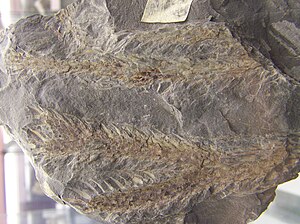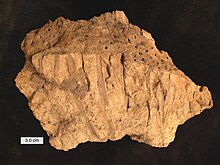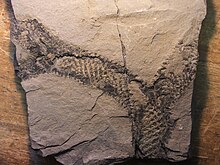Lepidodendrales
| Lepidodendrales | ||||||||||||
|---|---|---|---|---|---|---|---|---|---|---|---|---|

|
||||||||||||
| Temporal occurrence | ||||||||||||
| Devonian to Permian | ||||||||||||
| Systematics | ||||||||||||
|
||||||||||||
| Scientific name | ||||||||||||
| Lepidodendrales | ||||||||||||
The Lepidodendrales (from Greek lepis , 'scales') are an extinct group of the bear moss plants (Lycopodiopsida). They occurred from the Devonian to the Permian . Their tree-shaped representatives reached heights of over 40 m and formed the coal swamp forests of the northern hemisphere. Due to the large number of finds, the Lepidodendrales are the best known group of fossil club moss plants.
features
The representatives of the order Lepidodendrales are characterized by the presence of a ligula , secondary xylem , a thick periderm and a tripartite cortex . They have spirally arranged, root-like appendages with a monarchic vascular bundle . They form a single functional megaspore per megasporangium , which germinates in the sporangium.
The characteristics of the two families Lepidodendraceae and Diaphorodendraceae are discussed below. These representatives of the two families used to be grouped together in the organ genus Lepidodendron due to their scale-like leaf scars on the trunk .
Vegetative characteristics
The trees were over 40 m high with a trunk diameter of at least 2 m ( lepidodendron ). However, many representatives remained much smaller. Diaphorodendron vasculare, Diaphorodendron scleroticum and Diaphorodendron phillipsii include trees 8 to 20 m in height, representatives of Synchysidendron were 10 to 15 m high. The shoot axes consist mainly of the bark , not of the wood , as is the case with recent trees . Even with twigs 20 mm in diameter, the bark takes up more than 98% of the volume, with recent trees only around 25%.
- Stem surface and leaf bases
The most common fossils in the group are imprints of the trunk surface. This is characterized by permanent, somewhat asymmetrical, more or less rhombic leaf cushions. The leaf cushion is the remnant of the widened leaf base that remains, as the leaf does not completely fall off when the leaf falls. The top and bottom of the leaf pad are sharp angled while the sides are rounded. The actual leaf scar sits slightly above the center of the leaf cushion and is usually elliptical to rhombic. There are three small pits in the area of the leaf scar. The middle one corresponds to the single vascular bundle that supplies the leaf. The two sides mark the two Parichnos strands, loose ducts parenchyma . The parichnose tissue arises in the bark and runs through two pits on the abaxial side of the leaves. In Lepidodendron there are two additional Parichnos canals that emerge on the stem surface just below the leaf scar. These two are absent from the Diaphorodendraceae. Directly above the leaf scar is a mark that shows the position of the ligula .
The epidermis has a waxy cuticle and is simply without special cells such as trichomes or glands. Stomata are common and sunk into shallow pits.
- Stem anatomy
The trunks of Lepidodendrales are protosteles ( diaphorodendrons ) or siphonosteles ( diaphorodendrons and lepidodendrons ), or have a mixed pulp . Stems with protosteles have a central strand of primary xylem , which is surrounded by a narrow ring of protoxylem, which in turn is surrounded by secondary xylem. With mixed marrow there are parenchymal cells mixed with tracheids in the center , the shape of the tracheids more closely resembling short parenchymal cells than long, slender cells. This is seen as a sign that the evolution of the pulp in the Lepidodendrales led to tracheids in the center via a no longer completed differentiation of the cells. Ladder tracheids occur in the metaxylem. The xylem ripens exarch.
Around the primary xylem there can be a narrow ring of secondary xylem that is a few centimeters at most. The tracheids in the secondary xylem are ladder tracheids. Tracheids in the primary and secondary xylem have fine longitudinal bars between the ladder steps, so-called Williamson stripes. A number of rays that are one cell wide and several cells high pass through the secondary xylem.
Thin-walled cells, the cambium, lie directly outside the secondary xylem . This is a unifacial cambium, it only subdivides secondary xylem inwardly, secondary phloem is not formed.
The phloem is separated from the secondary xylem by a band of thin-walled cells called the parenchymal sheath. Screen elements with large, elliptical screen fields connect to the outside of this sheath. Between these are strands of phloem parenchyma. According to the current state of knowledge, secondary phloem was not formed.
- Bark tissue
The bark of the Lepidodendrales is divided into three zones - an inner, middle and outer - which are characterized by certain cell types. The inner cortex is the narrowest zone and consists of small, isodiametric parenchymal cells. Cell clusters with dark content, possibly secretory cells , as well as lacunae and various sclerotic cells also occur here . The middle cortex is more extensive and consists of larger parenchymal cells. In young tribes this area is characterized by radially elongated lacunae, in older tribes this area is not preserved with the exception of a few parenchymal cells. The outer cortex consists of cells with somewhat thickened cell walls that resemble collenchymal cells.
The secondary cortical tissue or periderm is formed in the outer cortex. It is very extensive and represents the largest part of the trunk diameter. In the Diaphorodendron , the periderm consists of two zones, an inner phelloderm and an outer phellem . The inner zone consists of alternating thick and thin-walled cells with dark content, which is interpreted as resin. Lepidodendron has a massive periderm that is uniform or two-layered.
The phellogen of the Lepidodendrales formed little phellema on the outside, but a large amount of phelloderm on the inside - in contrast to today's seed plants.
For the periderm there were different types of formation within the lepidodendrales. Some species show multiple tangential bands of meristematic tissue. Here, outer layers of cortex become meristematic and form rows of cells arranged radially for a certain period of time. After a while they stop dividing activity and a new layer becomes meristematic and forms a new periderm.
- leaves

As with all bear moss plants, the leaves are microphylls . They are linear, some up to 1 m long, but mostly much shorter. The length correlates with the diameter of the stem section on which the leaves sit. This correlation is attributed to the determined growth of the lepidodendrales. Different species have been established for leaf fossils found in isolation, but mostly leaves of different sizes from different areas of a plant are involved. The old name Lepidophyllum had to be replaced by Lepidophylloides , since it was already given for a flowering plant . A single vascular bundle runs through the entire leaf blade, which is accompanied by two shallow grooves on the abaxial surface. The stomata are also placed abaxially and are arranged in rows parallel to the pits. They are placed in shallow pits.
The leaves have a pronounced hypoderm made of fibers that surrounds the mesophyll parenchyma and the central vascular bundle. Palisade parenchyma is unknown.
- Underground organs
The underground organs of the Lepidodendrales are referred to by the generic name Stigmaria or as Stigmarien. They branch dichotomously, are among the most common bear moss fossils and occur mainly in the clay layers directly below the coal layers. The anatomy is mainly known from studies on Stigmaria ficoides .
From the base of the trunk arise four main axes that run horizontally, the root system is shallow. Lateral appendages are arranged helically. These are repelled in the further course of growth and leave characteristic circular scars on the main axis. The side-appendages are sometimes referred to as Stigmarien fine roots; however, their helical arrangement and repulsion are more typical of leaves than fine roots.
The main axes branch dichotomously in multiple ways and form an extensive underground system that can reach a diameter of 15 m. The main axes have a parenchymal marrow . The primary xylem matures endarch and is arranged in a series of ribbons and in turn surrounded by a cambium . The secondary xylem is characterized by wide rays that give the wood a segmented appearance. The tracheids of the secondary xylem are arranged in radial rows and have ladder-shaped thickenings with characteristic longitudinal beams. Secondary phloem is absent in Stigmaria , the cambium was unifacial, the substance was only transported via the primary phloem.
Primary and secondary bark of Stigmaria ficoides have a complex structure made up of different cell and tissue types. The formation of secondary bark tissue resulted in a narrow zone of periderm similar to that in the above-ground axes.
The side appendages are up to 40 cm long and 0.5 to 1 cm in diameter. They are mostly unbranched, at most once dichotomously branched. They gradually narrow towards the tip. Each appendage has a single, small monarchic vascular bundle , which is surrounded by a compact inner bark. This is followed by a hollow middle and a thin outer bark zone. The vascular bundle is bilaterally symmetrical and collateral. These and the features listed above led to the interpretation that these appendages are not homologous to the roots but to the leaves and have been converted for the function of anchoring and nutrient uptake. Accordingly, the main axis of the stem axis would also be homologous.
Protostigmaria from the early Mississippian has a bulbous subterranean axis on which the lateral appendages are screwed. It is divided into several lobes by furrows, and more furrows were added as it grew. Protostigmaria was probably the underground part of Lepidodendropsis , a tree-shaped representative of the Lepidodendraceae.
Root hairs are not yet known; the lepidodendrales may have formed a mycorrhiza with fungi . In some fossils, fungi have been found in cells of the bark parenchyma.
Reproductive organs
The reproductive organs of the Lepidodendrales are cones that are formed on distal branches in the tree canopy. These can be branches that form late as in Synchysidendron , or later discarded side branches as in Diaphorodendron . The cones were up to 50 cm long ( Lepidostrobus goldenbergii ). A cone consists of a central axis on which the sporophylls are arranged in a helical arrangement. The sporangia are on the adaxial (upper) side of the sporophylls, the end sections of which are bent upwards and overlap the upper sporophylls. The ligula sits in a small pit directly in front of the sporangium. Most of the fossils were placed in the genus Lepidostrobus . Attempts were made to divide the genus, whereby in 1983 Brack-Hanes and Thomas left only the monosporangiate cones (with one type of spores) in this genus and the bisporangiate cones (with two types of spores) in the genus Flemingites .
- Microsporangiate and bisporangiate cones
Lepidostrobus oldhamius from the Lower and Middle Pennsylvania of North America and Great Britain are up to 30 cm long and two to six centimeters in diameter. The sporangia are massive and have an irregularly shaped cushion of sterile tissue that extends from the sporophyll into the lumen of the sporangium. All sporangia contain small spores of 20 to 30 micrometers with a trilete (three-rayed) scar and fine spines on the distal side. Released spores of this type are placed in the genus Lycospora .
Flemingites schopfii is a bisporangiate cone about 8 cm long and 1.3 cm in diameter. The cones are similar to those of Lepidostrobus oldhamius , but there are two types of spores: distal sporangia form large numbers of small Lycospora- like spores, the sporangia below form 12 to 29 trilete megaspores 700 to 1250 micrometers in diameter.
Monosporangiate cones are often interpreted as the microsporangiate cones of heterosporous plants. But they can also be the cones of homosporic plants analogous to the recent Lycopodium .
- Megasporangiate cones
Some cones are monoporangiate, but only form megaspores. The most common cones are lepidocarpone , which is one of the tribes of Lepidophloios . Lepidocarpon is the most highly developed reproductive structure of the bear moss plants : the arrangement of the sporophylls corresponds functionally to the integuments of the seed plants . The sporangia are located adaxially to the surface of the sporophyll. A sporophyll consists of two lateral blades and a distal shoulder. The lateral blades envelop the sporangium in such a way that a slit-shaped opening remains only at the tip. Only one large megaspore ripens in the sporangium, while the other three wither. The wall of the megaspore, which when found singly is called cystosporites , is made up of loosely grouped strands of sporopollenin , a unique feature. The megagametophytes form a few archegonia. The embryos are ellipsoidal, without vascular bundles and have a folded epidermis. During growth, the axis, which is then provided with vascular bundles, divides dichotomously: one branch develops into the stem axis, the other into the subterranean Stigmarien system.
Other cone genera such as achlamydocarpone lacked this integument-like covering of the sporangia. Achlamydocarpon is considered to be the cones of various species of the genus Diaphorodendron .
- Gametophytes
Knowledge of the gametophytes is based on a few findings. Micro- and megagametophytes are more often preserved in Flemingites schopfii cones. Parenchymatic, cellular megagametophytes are sometimes found in the megaspores near the triple scar. Some of the cells on the surface have rhizoids that protrude from the scar and even pierce the wall of the sporangia. Archegonia have one to three layers of neck cells and a large abdominal cell underneath. Some microspores from the same species show stages in the development of the microgametophytes, for example the division into antheridia initial and prothallium cell. Some cells contain material that morphologically resembles chromosomes . In general, the microgametophytes more closely resemble recent Selaginella , while the megagametophytes resemble recent Isoetes .
In Lepidodendron esnotense and Lepidodendron rhodumnense , the megagametophytes are multicellular structures that develop within the megaspore wall (endospor). At maturity they pierce the trilete scar, there form a mass of tissue in which several archegonia arise. Rhizoids are absent here.
Systematics
The Carbon Age lycopsids are now mostly divided into three or four families , with the first three being monophyletic , while the fourth is a rather poorly defined, paraphyletic group:
- Lepidodendraceae and
- Diaphorodendraceae : the first two families include species that were formerly placed in the form genus Lepidodendron mainly because of their stem characteristics as shed trees .
- Sigillariaceae includes the seal trees, which were recognized early on as a separate group.
- Ulodendraceae
The families of the Lepidodendrales are put by some authors to the Isoetales , which then include all rhizomorph-forming groups.
Distribution and importance
The tree-shaped lepidodendrales largely built up the carbon forests from which the coal in Euramerica originated. In the Westfalium ( Upper Carboniferous ) they formed up to 70% of the biomass of the coal swamp forests. This proportion fell to around 5% in the subsequent Stefanium . At the end of the Carboniferous, the lepidodendrales died out in Europe and America, and in China they survived into the Middle Permian. The reasons for their extinction are believed to be a drier climate, tectonic activity that led to less swamp areas, or a combination of both.
supporting documents
- William A. DiMichele, Richard M. Bateman: The Rhizomorphic Lycopsids: A Case-Study in Paleobotanical Classification . Systematic Botany, 1996, Vol. 21, pp. 535-552.
- Thomas N. Taylor, Edith L. Taylor, Michael Krings: Paleobotany. The Biology and Evolution of Fossil Plants . Second Edition, Academic Press 2009, ISBN 978-0-12-373972-8 . Pp. 279-309.
Individual evidence
- ↑ Walter Zimmermann : Phylogeny of Plants . 2nd edition, G. Fischer, Stuttgart 1959, p. 180. (without ISBN)



